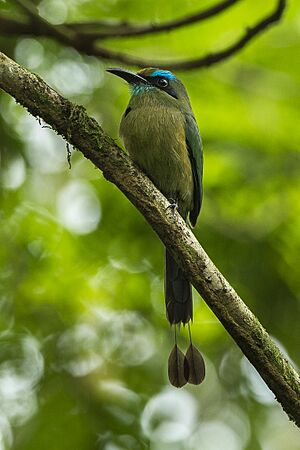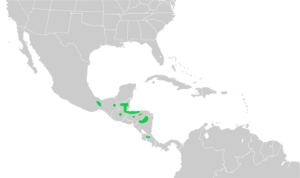Keel-billed motmot facts for kids
Quick facts for kids Keel-billed motmot |
|
|---|---|
 |
|
| Conservation status | |
| Scientific classification | |
| Genus: |
Electron
|
| Species: |
carinatum
|
 |
|
| Synonyms | |
|
Prionirhynchus carinatus |
|
The keel-billed motmot (Electron carinatum) is a beautiful and colorful bird that lives in the tropical forests of Central America. It belongs to a family of birds called motmots. These birds are known for their bright feathers and unique tails. The keel-billed motmot is quite similar to another bird, the broad-billed motmot. They are about the same size and shape, and even sound alike. However, their feathers look a bit different.
Contents
Where Do Keel-billed Motmots Live?
This amazing bird can be found in several countries in Central America. These include Belize, Costa Rica, Guatemala, Honduras, Nicaragua, and Mexico.
They prefer to live in warm, wet forests. You can find them in tropical lowland forests, which are close to sea level. They also live in tropical montane forests, which are found on the sides of mountains. Usually, they live below 750 meters (about 2,460 feet) in elevation. But in Honduras, they can be found much higher, up to 1,550 meters (about 5,085 feet).
What Does a Keel-billed Motmot Look Like?
The keel-billed motmot is a medium-sized bird for its family. It measures about 30.5 to 38 centimeters (12 to 15 inches) long. Male motmots weigh around 68 grams (about 2.4 ounces).
Their feathers are mostly green, with a greenish-brown color on their undersides. They have a reddish forehead and a black mask across their face. Above their eyes, there's a bright blue stripe. Their chin is a pretty turquoise color, and they have a black spot on their chest. Their bill (beak) is long, wide, and has small saw-like edges. One of their most special features is their long tail, which ends in two unique feather shapes that look like little rackets!
Keel-billed Motmot Behavior and Reproduction
Scientists don't know a lot about how these birds behave every day. They are quite shy and hard to spot in the wild. We do know that they hunt for insects from a perch, just like other motmots. This means they sit on a branch and then quickly fly out to catch a bug in the air.
When it comes to their reproduction and raising young, even less is known. We do know that male motmots make special calls to mark their territory between January and March. Their nests have been found in burrows, which are like tunnels, dug into the banks of streams. In Belize, some nests have even been found in the sides of old, untouched Mayan ruins!
Why Are Keel-billed Motmots in Danger?
Sadly, the keel-billed motmot is considered a "Vulnerable" species by the IUCN (International Union for Conservation of Nature). This means they are at risk of becoming endangered.
The biggest threat to these birds is the fast loss of their forest homes. Their forests are being cut down for farming and other human activities. These birds need large areas of old, undisturbed primary forest to survive. Many places that seem like good homes for them actually don't have any motmots.
Scientists believe the largest group of keel-billed motmots lives in Belize. Interestingly, people thought this bird had completely disappeared from Mexico, but it was found again in 1995! Protecting their forest homes is very important to help these beautiful birds survive.


